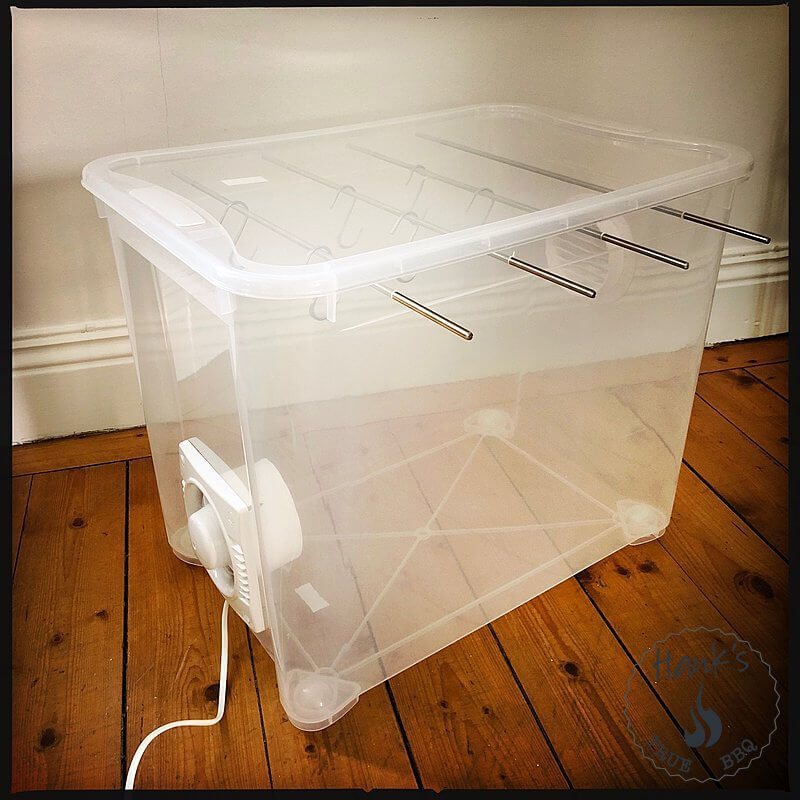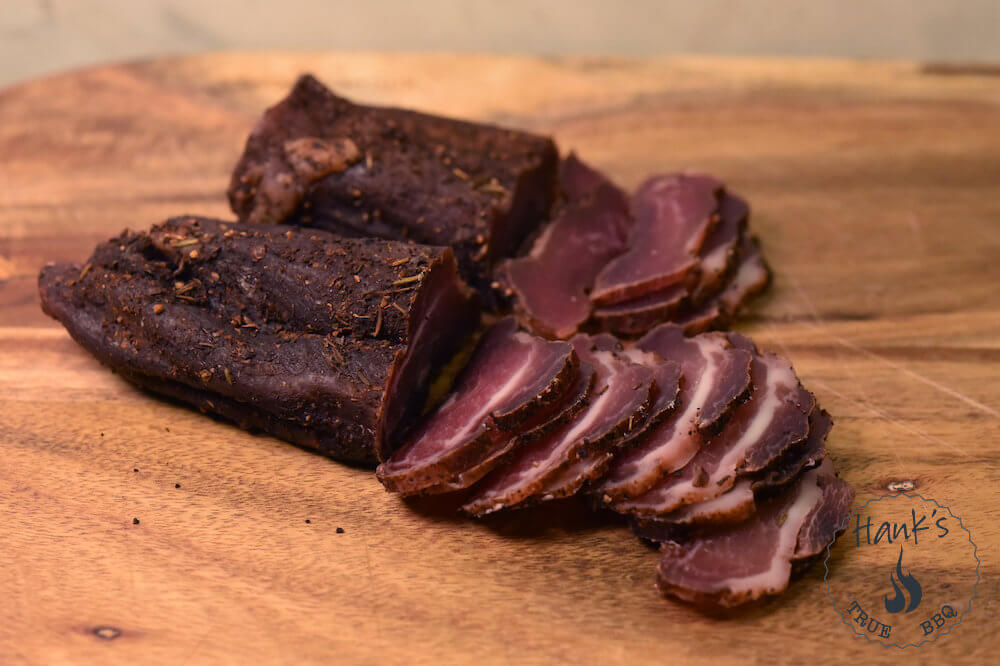Curious about what a Biltong Box is? Read on to get the lowdown.
A Biltong box is named after the meat cured in it. It is a South African term, and it’s somewhat similar to Beef Jerky in the US or Charqui in South America. It is basically a preservation method. The fan is there to continually extract air from the box. This way the moisture is drawn out. The whole process takes anywhere from a few days to a few weeks, it all depends on the thickness of the meat. I typically use thinner strips, that way it doesn’t take more than 1-2 weeks. The process is extremely simple on the other hand, all you do is wait, there is zero effort once the meat is hung in the box.
Construction
The box can be bought off the shelf or hand made from cheap parts. I built my own from a plastic storage box, a few round bars, a fan and a vent. Most if can be found at Home Depot and similar stores. I did make sure to place the intake vent at the top, and the extraction fan at the bottom, on the opposite side. The reason I did this is to make sure there are no stale air pockets in the box. The air now has to travel diagonally.

Some (larger) boxes contain a (traditional) lightbulb. The lightbulb is there not to warm things up too much, but it will warm up the surrounding air. Warm air rises, and that creates a natural draught. I’m advocating a fan instead, that way you have zero temp increase, and the moisture is drawn out anyway. If you have a heat source there is a risk that the outside of the meat dries faster than the inside.

I place my box in the basement where it is 15 deg C (60 deg F). It is slightly cooler than room temp, and that is good.
Types of meat
Any meat can be dried in the box, really, but I believe beef is most common.
Preparation
When prepping the meat, always apply good hygiene. You don’t want foreign growth on the meat. I use nitril gloves. In order to get the most flavor, I strongly recommend a wet brine. I normally recommend dry brining, but for this type of application it is easier to control the salt level. I typically use an 8-10% brine. Read more about how to create a wet brine here. Leave the meat in the brine overnight, then take it out and pat it dry with a paper towel.
A Note on Vinegar
Many recipes call for vinegar in some sort. Sometimes for flavor, sometimes for purposes of preventing mold. I typically don’t use it, but many people associate the vinegar flavor with Biltong. As for the mold prevention: If you place clean meat in the box with a good low rpm fan, then you don’t need vinegar.
Flavor
I apply one of my bbq rubs, but choose whatever herbs/spices you have at home, or prefer. Apply the spices/rub, and leave it in the fridge (covered) for a few hours. You want to give the rub some time for the flavors to blend before starting to dry the meat.
Hanging
This is the easy part. Simply hook the meat, making sure it doesn’t touch any part of the box. Put the lid on, start the fan and wait. Easy, right?
How to tell when it’s done
Look at it, and pinch it with your fingers. The outside should be dry and leathery, but you still want some softness in the middle. There should be a slight ‘give’. In the photo(s) above I dried some Wildboar tenderloin, and they are quite thin. They took 2 weeks to dry. But start checking (with nitrile gloves) after a week. If you over-dry them they will be very tough and chewy.
Here’s a video where I show how it’s done and used:


Is there a ambient temperature that is too warm? For example I live in an apartment and it can get near 30C in the summers? I figure because people use light bulbs should be fine…
Secondly, will this make my apartment smell like biltong?
Thanks.
Well, I haven’t done scientific experiments, so I can’t give you an exact number or limit. But the constant airflow means drying the meat out, and as long as the meat is handled correctly before going into the box you should be fine. Check it regularly by looking at it. If you see unexpected discoloration and/or growth, just toss it. The same goes after it’s done, smell it, your nose is a great guide. As for the apartment smell: I don’t notice any particular odor, so you should be good.
Hi there. Where did you pick up that extractor fan? I looked online but all they have are the big bathroom ones which I don’t need.
I found it at the Swedish equivalent of Home Depot. Not sure where you can find it outside Sweden. I hope you manage to find one the right size.
Just use the cooling fan from a desk top computer. Works perfectly.
Hi Richard, did you have to put a 240, 220V / 12V converter on the fan to be able to plug into your house supply and an ON/OFF switch.?
Im going to give this a go…..will it work with dried fruit ? its for my dog that , im from Aberdeen in Scotland so i be on the angus beef , maybe a dog version for him with a dog friendly rub im thinking ……..im away to start finding parts for the box. I like this.
Do you mean will it work for drying fruit? Good question, I don’t know. I suspect it goes way quicker to dry fruit at low temps in the oven, but give it a try and see. As for dog friendly rubs – I would skip the rub altogether and just serve him/her the dried meat. If you’re gonna use a rub, at least skip the salt.
Pingback: Carne Seca (Brazilian Beef Jerky) - Texas de Brazil
Hank! Thanks very much for the good video and explanation. May I pls ask you to send me some links where I can buy that specific items to build my own box (i.e. via Amazon). Thanks! Cheers Bernhard
Hi Bernhard! Thanks, I’m glad it was of help. I live in Sweden and don’t shop from Amazon. It would take some time to do the research and find the items needed, plus verify that they all fit together so I can recommend them to others. I think that’s something better left to the reader/builder.
Cheers, Henrik
Pingback: How to Make Biltong (The Best Survival Meat) – qatarstrend.online
Pingback: How to Make Biltong (The Best Survival Meat) - Survivalist Briefing
Pingback: How to Make Biltong (The Best Survival Meat) - Survivalist Pros
Pingback: How to Make Biltong (The Best Survival Meat) - Power Puff Protection
Pingback: Zelf biltong maken: zo doe je dat! - Vuurfoodie